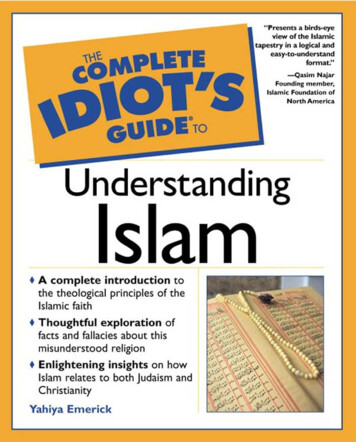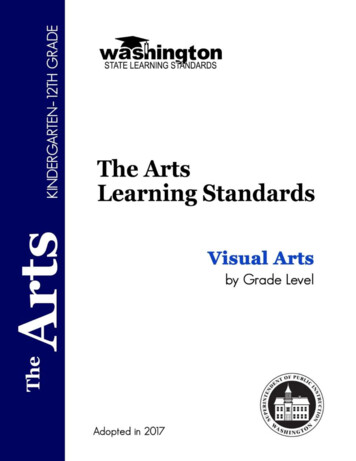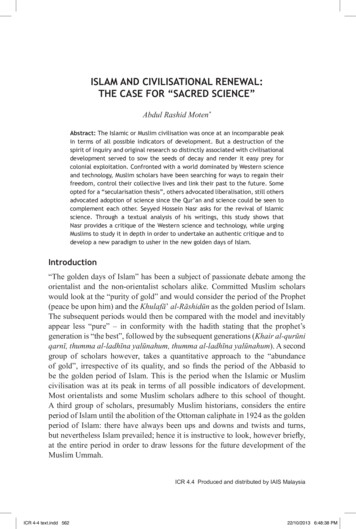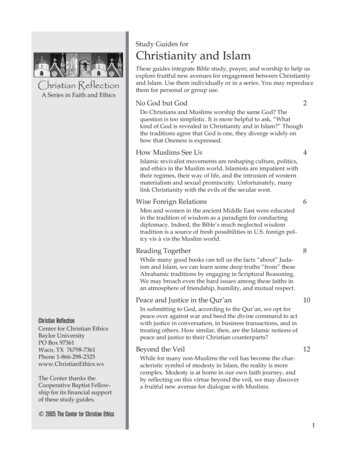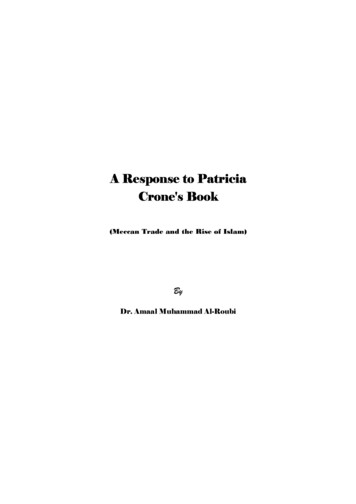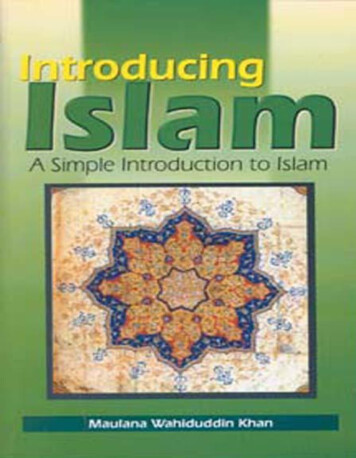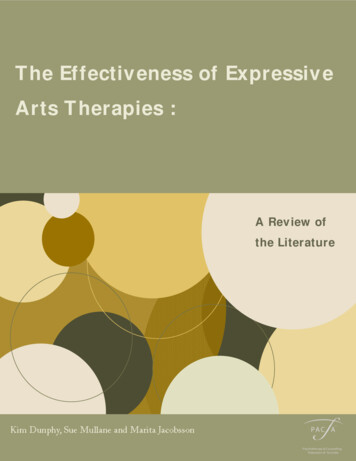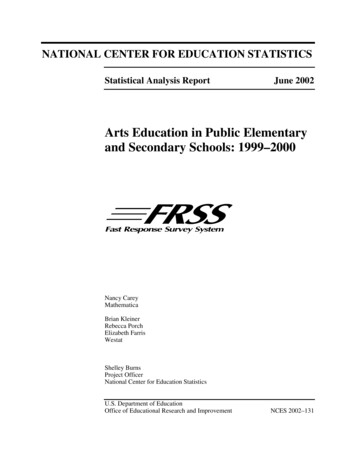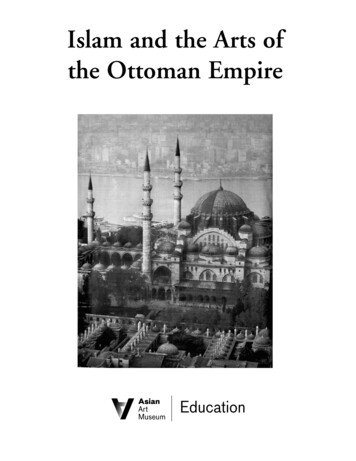
Transcription
Islam and the Arts ofthe Ottoman Empire
AcknowledgmentsPacket written and coordinated by Brian HogarthDirector of Education, Asian Art MuseumSection on Islamic Calligraphy written by Stephanie Kao,Program Coordinator, Asian Art MuseumParts of this packet have been adapted from the writings and lectures of others.These names, as well as other names we wish to thank, include:Professor Irene Bierman, UCLAAggie Brenneman, Park Day School, BerkeleyDeborah Clearwaters, Asian Art MuseumAlina Collier, Asian Art MuseumBindu Gude, Asian Art MuseumLinda Komaroff, Los Angeles County Museum of ArtProfessor Johanna Movassat, San Jose State UniversityProfessor Leslie Pierce, UC BerkeleyPortland Art Museum, Education DepartmentKristina Youso-Connoy, Freelance EditorTim Stanley, Khalili CollectionAsian Art Museum Education Department
Why Islam? Why the Ottomans?This packet accompanies the traveling exhibition, Empire of the Sultans, Ottoman art from theKhalili collection. The exhibition offers a glimpse of the artistic legacy of one of the great Islamicempires, the Ottomans. The Ottomans ruled over a vast empire that linked Europe, North Africaand West Asia for six centuries. Their history and art has had a profound influence on modernEurope and The Middle East.To understand the Ottomans as an Islamic culture, it is necessary to provide some backgroundon Islam and Islamic art in general. Teachers will find a summary of the beliefs of Islam as well asinformation on the Koran and on mosques. The Khalili collection is especially strong in the arts ofthe book, and for that reason we have included a section on Islamic calligraphy with related studentactivities.The Asian Art Museum–Chong-Moon Lee Center for Asian Art and Culture contains a small butimportant collection of West Asian and Islamic arts, particularly ceramics. A previous packet—TheIslamic Arts of Asia—covered some of these objects and provided some background materials onIslamic art. This packet, while concentrating on the Ottomans, includes a number of contextualslides that teachers can use in any lesson on Islamic history and culture.Points for discussionAside from viewing the slides, here are some points to consider with your students: How did Islam (as a religion) influence the arts of the Ottomans?How did calligraphy assume such an important position in Islamic art?Compare the mosque with other forms of religious architecture. List the main parts of amosque and describe its decorationDescribe the role of the (Ottoman) sultans and their life at courtHow did science serve the interests of the Islamic faith?What accounts for the expansion of the Ottoman empire in the 1400s–1500s? What wasthe role of the military? The government? The sultan as leader?What impact did the rise of the Ottoman empire have on Europe?Other suggestions:1. Draw a timeline listing some of the Ottoman sultans and events mentioned in this packet; havethe students research key dates for two other Islamic dynasties—the Safavids in Iran and theMughals in India; now list some of the key names in European history during that time and seehow they relate in time with the OttomansAsian Art Museum Education Department
2. Have the students research words and objects associated with the Ottomans and the Ottomanperiod such as: roissantDiscuss the origin of these words, and how their meanings have changed (or not changed) overtime.3. Discuss the role of Islamic carpets in terms of trade and exchange, as a practical householdobjects and as works of art.Asian Art Museum Education Department
Introduction to the Islamic worldWhat is Islam?Islam is one of the world’s major religions. It shares with Judaism and Christianity a belief in asingle god. The Arabic name for God is Allah. The word Islam means “surrender (to God).” Thefollowers of Islam are called Muslims, which in Arabic means “one who surrenders to God.”While Islam is mainly associated with the Middle East, its roughly one billion followers are foundthroughout the world. The largest Islamic communities exist in the nations of Indonesia, Pakistanand Bangladesh. There are also sizeable communities throughout West Africa, India, and in partsof China.Central to the beliefs of Islam is the idea of one, omnipotent God who transcends class, race, andnational differences. All Muslims therefore share a sense of community beyond national or ethnicboundaries. The process of conversion to Islam is fairly simple: one merely has to declare one’sfaith. There is no need for formal confirmation by a religious authority.Muslims believe in the word of God contained in the holy book called the Koran (sometimesspelled Qur’an or Kur’an), as revealed to the Prophet Muhammad by the angel Gabriel between610–623 ce in Arabia. They also follow practices known as the “Five Pillars of Islam.”The Five Pillars of IslamCentral to the Islamic faith are the essential duties and practices known as the Five Pillars of Islam.These are: The profession of faith or shahadaThe duty to perform five daily prayers or salatThe obligation to provide alms or zakatFasting during the month of RamadanPilgrimage to MeccaProfession of faith (shahada)The profession of faith is known as the shahada. It is the prerequisite for membership in theMuslim community, and an affirmation of the faith. Muslims are required to declare this professionin public at least once in their lifetime, but most Muslims recite it daily as part of their prayers.In Arabic, the shahada is as follows: “Ashhadu al-la ilaha illa-llah was ashhadu anna Muhammadarrasulu-llah” translated as “ I bear witness that there is no God but Allah and I bear witness thatMuhammad is His Messenger” or more simply, “There is no god but God and Muhammad is HisMessenger.”The profession of faith is designed not only for public affirmation, but also to encourage true conviction and sincerity of mind on the part of the worshipper. Seemingly simple, the phrase is absolutely central to the practice of Islam. Muhammad is reported to have said, “These few words areequal to one third of the Koran.”Asian Art Museum Education Department
Prayer (salat)Prayer is an essential duty of every Muslim, and the second Pillarof Islam. It is performed five times a day. These times are dawn,noon, mid-afternoon, sunset, and evening. Before prayer, thereis ritual cleansing and purification. Typically this means washingone’s hands, mouth, nose, face, ears, forearms, head, and feet threetimes with the right hand. If there is no water is available, sandmay be substituted.Prayer itself consists of three or four cycles of ritual bowing andprostration along with recitation of parts of the Koran and otherprayers in Arabic. All end with the phrase, “May peace, mercy andblessings be upon you.”Muslims can perform prayer just about anywhere, but the mostfavored place is in the mosque. A crier (muezzin) calls the faithfulto prayer (adhan). The holy day each week is Friday. The congregation of worshippers at the mosque is led by the religious leaderor imam. Prayers, wherever they take place, must be performed inthe direction of Mecca. This direction is indicated by the kiblah, aword meaning “direction of prayer.” It is indicated in a mosque by a wall (referred to as the kiblahwall) that is usually marked by a niche called the mihrab.Almsgiving (zakat)The third Pillar of Islam is a call to charity. There are two categories: compulsory and voluntary.Compulsory almsgiving resembles a tax for all Muslims, payable to either the community or state.It is calculated on the basis of one’s possessions and income, and usually equates to 2.5% of aperson’s annually accumulated wealth. This system ensures that the poor will be at least partlyprovided for and encourages a sentiment of sharing among the various social classes. Almsgivingalso has spiritual value, as a way of atoning for one’s sins and ensuring salvation in the afterlife.Voluntary almsgiving (sadaqa) should be performed freely and spontaneously, with discretion andsincerity.Fasting (abstinence)Fasting (sawm) is a ritual observance during the month of Ramadan, the ninth month of theIslamic calendar. Muslims are required to abstain from eating, drinking, and sexual activitiesbetween sunrise and sundown. Nursing and pregnant mothers, the sick, and children up to the ageof puberty are permitted to break the fast. Ramadan is important, because it marks the time in theyear when the Koran began to be revealed to Muhammad.Pilgrimage to Mecca (hajj)All Muslims who have the physical and materials means to do so are encouraged to visit Mecca atleast once in their lifetimes. The pilgrimage occurs during part of the twelfth month of the Islamiccalendar. Modern transportation allows millions of Muslims to make the pilgrimage to Mecca,Asian Art Museum Education Department
where the focus is the structure known as theKaaba (see slide #1). Pilgrims wear white, symbolizing the equality of all Muslims before God.Having arrived at Mecca, each pilgrim typicallywalks around the Kaaba seven times. This is followed by a set of other ritual observances such aswalking between the hills overlooking the Kaaba,standing on Mt.Arafat, and traveling to nearbyMinah, all sites that commemorate aspects ofIslamic history and faith. Pilgrims also frequentlyvisit the Dome of the Rock in Jerusalem andthe Mosque of the Prophet in Medina. Both themonth of pilgrimage to Mecca and the month ofRamadan end in festive celebrations.The KoranThe Koran is a record of the divine wordsrevealed to the Prophet Muhammad by the angelGabriel. Muhammad memorized these words andtransmitted them orally. They were compiled inwritten form several decades after his death.Illustration of pilgrims en route to Mecca, 1200s.The word Koran means “recitation.” The Koran is recited by Muslims as an act of commitmentin worship during prayer. The Koran is considered to be miraculous, and its divine authorshipis proven by the principle of inimitability (i’jaz); that is, no human can match its language andbeauty.Muslims believe that the Koran contains the last revealed words of God, updating earlier revelationsgiven to Abraham, Moses, and Jesus. Because the Prophet Muhammad spoke God’s word in hisnative Arabic and the divine message was first written down in Arabic, the Arabic language is theone true language of the revelation. For Muslims, a true Koran is never translated into other languages, neither into Turkish, Persian, nor the languages of Southeast Asia or West Africa, despitesubstantial Muslim populations in these areas. All Muslims must recite the Koran and all prayersin Arabic. Arabic is therefore the central unifying force of Islam, serving to bind together believersthroughout the world.The Koran contains 114 chapters called surah. Except for the opening chapter, these are arrangedaccording to length from the longest to the shortest. Initial chapters concern the legal and political problems of the original community of believers at Medina, while the later ones provideMuhammad’s ethical messages. Each chapter, except one, begins with the phrase known as bismillah: “In the name of God, the Merciful, the Compassionate.” Traditionally, Korans were bound ineither one or two volumes or separated into thirty parts.The study of the Koran and its teachings was especially emphasized in madrasa, institutions ofhigher learning that were part of the complex surrounding every mosque. A thorough grounding inArabic was either a prerequisite for entry into—or part of the core curriculum of—every madrasa.Writing practice was extremely important. Calligraphy became the most highly revered art form inthe Islamic world.Asian Art Museum Education Department
Islamic lawOver the centuries following the birth of Islam, scholars worked diligently to establish the authenticity of various sayings attributed to the Prophet. Such sayings often emergedin support of theclaims of various sects. Scholarly efforts culminated in the compilation of several collections knownas Hadith, two of which are considered to be especially important. Islamic law developed principally from the Koran and the Hadith as primary sources of interpretation. If references could not befound in these primary sources, they were found by reference to legal analogy or qiyas (a precedentfrom a similar situation that arisen before), or through the consensus of the community or ijma.Islamic law is collectively known as the Sharia. Sharia literally means “ the path leading to water.”In other words, the law leads to the source of life.In the West, church and state evolved in ways that govern different aspects of individual life, but inthe Islamic world, religion permeates all aspects of one’s life. Islamic law determines such things asgreetings, drinking and eating habits, dress, the relationship between men and women, and muchmore. This adherence to religious custom does not stem (as is sometimes the view from the West)from a willingness to live in a state of oppression, but rather proceeds from the belief that all lifeextends from the will of God, and to act in accordance with the divine will is to live in harmonywith what is right and true. Thus, even the smallest mundane activities can be imbued with religious significance.Mystics and scholarsIslamic mysticism, or Sufism, was a distinct tradition within Islam that aimed to cultivate innerspiritual life. Sufism probably derives from the word suf, meaning wool, a reference to the woolenclothing worn by early Sufi mystics.The focus of Sufism changed over the centuries as Islam grew and expanded. Initially moved by thefear of God, Sufism eventually adopted an affirming doctrine of love, and later the concept of thespiritual journey of the individual towards God. Sufism certainly appealed to worshippers on anemotional level. Sufi masters or shaikhs attracted disciples. New practices such as singing, dancing,and the worship of saints were introduced into the faith.Sufi claims to experience God directly led to conflicts with learned scholars or ulama, who insistedon faith based on learning the scriptures. The ulama focused their efforts on the transmission ofknowledge through institutional means, through teaching in schools, and the administration ofother social organizations such as hospitals and orphanages. Both Sufi mystics and ulama (scholars)traveled extensively throughout Arab lands and beyond in search of knowledge and to help spreadthe faith.Islamic cultural achievementsHistorians frequently remind us of the many contributions that Islamic peoples have made to worldculture. Many argue that the Islamic world is at the heart of world civilization, particularly duringthe medieval period.Historically, Arab scholars made their most significant achievements in the areas of science, mathematics, astronomy, geography, and medicine. These accomplishments include our present systemAsian Art Museum Education Department
of numbers, the development of algebra and trigonometry, the beginnings of optics, and the development of various instruments for navigation according to stellar movement, tools that eventuallyaided western explorers. In medicine, Arab scholars kept alive the work of the Greek Hippocrates,advising that doctors observe the patient in order to determine the cause of illness. Arab medicaltexts were transmitted to Europe and were still in use there through the 1600s.Other significant accomplishments include the organization of the military and state administration, textile and carpet production, the use of various spices for foods (which crusaders returningfrom the Holy Land introduced to Europe), and much more. (Islamic artistic achievements areexplored elsewhere in this packet.)Asian Art Museum Education Department
The history of Islam (to the 14th century)Beginnings: the life of MuhammadIslam arose through the life and teachings of the Prophet Muhammad, in the world of the Arabianpeninsula. In the early centuries ce, the Arabian peninsula was home to various nomads, who laterbecame known as Bedouins. By the 400s, some of these groups had established settlements such asthe town of Mecca where Muhammad was born. Mecca was growing as an important stop on thecaravan routes that linked Arabia with the present day regions of Egypt, Palestine, Syria, and Iraq.Political power at the time was split between two competing empires—the Sasanians to the northeast, and the Byzantines to the west. The rise of Islam would upset this balance of power and createa new order.The inhabitants of Mecca believed in numerous gods. Despite the presence of Christianity andJudaism, many people had trouble accepting the idea of worship as a means to ensure salvation inan afterlife. When later Islamic writers and historians wrote about these pre-Islamic peoples, theycharacterized the non-believers as idol worshippers. Islam called the Jews and Christians “the peopleof the book” because they shared a similar heritage, even though the message of the Prophet supplanted their teachings.Muhammad was born approximately 570 years after the birth of Christ. He was orphaned at theage of five or six and was subsequently raised by his grandfather and paternal uncle. He belonged tothe Hashim clan, a sub-group of the Quraysh tribe that dominated Mecca.During his early adult life, Muhammad was employed as a caravan driver for a rich merchantwoman named Khadija. The two eventually married (despite the difference in age, Muhammad wastwenty five, she was forty) and had six children (two of whom did not survive). Muhammad’s lifewas relatively unremarkable until the age of forty, when he began to receive revelations in a series ofvisions and angelic voices. Understandably, this caused a crisis in Muhammad’s life, but there wasno denying the authority of the message, and so he began to preach.The citizens of Mecca did not take kindly to the Prophet’s words, for he bluntly repudiated theprevailing practices (including the worship of tribal ancestors) proclaiming instead the omnipotence of the one true God. With a handful of followers, he was eventually forced to flee the cityin 622. This journey is known as the Hijra and marks the beginning of the Muslim calendar (year1). The city to which Muhammad fled—Yathrib—was renamed Medina, from Madinat-al-Nabi,“the city of the Prophet.” It was the first city to be guided by the new Islamic beliefs. Muhammadenvisioned a social order based on equality and justice rather than on tribal and clan associations.The revelations he had received provided not only a vision of one God, but also guidelines forproper conduct and righteous living. All aspects of one’s life were to be lived as though in the sightof God. Worship was directed towards Mecca—the site of a holy sanctuary known as the Kaaba,which represented God’s presence on earth. The Prophet’s own house became the first masjid(mosque) where worship took place, and a freed black slave named Bilal was the first to call thefaithful to prayer.During his time in Medina, Muhammad was able to consolidate his followers and build allies.Commercial trade going to Mecca was disrupted to such an extent that he was able to negotiate atruce with the rival city. Roughly ten years after his flight, Muhammad returned with an army ofAsian Art Museum Education Department
followers and conquered the city of Mecca, almost without bloodshed. Medina and Mecca werethus established as two of the sacred sites associated with the birth of Islam. By the Prophet’s deathin 632, the Muslim community dominated western Arabia.The Dome of the Rock in Jerusalem isconsidered to be the third most sacredsite in Islam. It marks the site whereMuhammad miraculously journeyed toheaven one night. The structure wasrestored during the Ottoman period.Photo: Kathleen Cohen.The spread of Islam—600s to 1300sAfter Muhammad’s death, the question of succession was the most pressing problem. Abu Bakr,the Prophet’s father-in-law, became the first successor, later referred to as “caliph.” He quickly subdued rival claims and oppositions groups. By 634, the whole Arabian peninsula was brought underhis control. Within a few decades, after remarkable victories against Byzantine and Sasanian forces,this territory had expanded to include most of present-day Iran, Iraq, Syria and Egypt. Ferventbeliefs combined with military campaigns became known as jihad, the holy war designed to bringnon-believers into submission. (The word jihad is used now more often to describe any struggle oreffort that one goes through as part of the faith.)The first major divisions of the faith occurred in 656, with the murder of the third caliph Uthman.Succession was the major problem once again. A man named Ali was proclaimed as the new caliph,but he was contested by leaders of the Umayyad clan. The Umayyads assumed leadership in 661after Ali was assassinated. Followers of Ali, known as Shi’ites, rallied around Ali’s son al-Husayn,but al-Husayn and his family were killed by Umayyad forces in 680. Shi’ites formed a separatebranch within Islam. The majority of Muslims became known as Suunis. Major divisions of theMuslim community to this day are still based on different interpretations of these events.The period of the first caliphs and Umayyad dynasty came to end with the military takeover bythe Abbasid family in 750, claiming descent from the Prophet’s uncle. The capital moved fromDamascus in Syria to Baghdad. The Islamic world was continuing to expand during this time. Newcampaigns brought North Africa under Islamic rule. Muslim forces reached into Europe, only to behalted in the Loire region by the Franks under Charles Martel. The areas around Bukhara, Ferganaand Samarkand came under Islamic control, and Muslim armies pushed into Pakistan and theIndus river valley.The Abbasid caliphs established a professional army made up of foreign soldiers called mamluk,and at one point, a new city had to be built to separate the non-Arab soldiers from the citizens ofAsian Art Museum Education Department
Baghdad. By the middle of the 900s, the Abbasid caliphs were largely figureheads, with real powerbeing held by powerful military figures. Later, the Mamluks would go on to establish their owndynasty.Gradually, the Islamic world was breaking up into competing dynasties. In North Africa, descendents of the Prophet’s daughter Fatima established a new dynasty based out of Cairo. In 756,an Umayyad prince who had escaped the Abbasid takeover founded a new dynasty in Spain thatwould lead to a great flowering of culture there from the 800s to the 1100s. Similarly, an Iraniandynasty arose in the east with the Samanids (819–1005). They were loyal to the caliphs, but essentially operated as an independent state. Under their leadership, there was cultural flourishing. Forexample, the Persian national epic, the Shahnameh, was written during this time. The Samanidswere overtaken by the Ghaznavids and then by the Seljuks. The Seljuks and Samanids were the firstgroups to use the term “sultan” (“power”). From this time on, Turkish-speaking peoples continuedto migrate into Islamic territory, and were to play an increasingly important role in the formationof succeeding dynasties.The 1100s and 1200s brought significant changes throughout the Middle East and Central Asia.With the downfall of caliphs came an end to a period of single rulers overseeing all Islamic states.The dream of a single guardian of the faith, however remained a goal for many future dynasticleaders. For example, when the Ottomans later took control of Medina and Mecca in the 1500s,they assumed a role similar to that of the earlier caliphs in governing the area considered the heartof Islam.From the west came the crusaders, bent on restoring Christian control over the Holy Lands. AKurdish officer named Saladin seized the opportunity to take control of the region and defeatedthe crusaders at the battle of Hattin in 1187. Isolated pockets of crusader strongholds held out foranother century. From the east came the invading Mongol forces. Sweeping down from northernIran and the Caucasus, they defeated the Seljuks in 1243 and seized Baghdad in 1258. Their westward advance was finally halted in Egypt by Mamluk forces. A century later, Timur (Tamerlane)attempted to re-establish the Mongol empire from his capital at Samarkand, but his project wasshort lived. The Mongol invasions uprooted populations, including Turkish-speaking peoples, whowere pushed into the region of Anatolia (present-day Turkey). This migration set the stage for therise of three great Islamic dynasties—the Ottomans in Anatolia and the Middle East, the Safavidsin Iran, and the Mughals in India. (The story of the Ottomans is described in a separate section ofthis packet.)Asian Art Museum Education Department
An Overview of Islamic ArtThe term “Islamic art” is somewhat misleading, as it implies art produced only for religious purposes. In fact, what is described as Islamic art includes much more. Islamic art encompasses notonly the arts of the mosque, the Koran, and other religious texts and artifacts, but also secular artsproduced for the states, rulers, and dynasties that followed the Islamic faith. Islamic art includesmany media, materials, and functions—in the arts of worship, the arts of trade and commerce, historical, scientific and government documents, items of personal adornment, metal arts, ceramics,woven textiles and carpets.Some general characteristics of Islamic art are listed below, followed by a section on the mosque asan architectural form, and a discussion of Ottoman arts and patronage.Some general characteristics of Islamic artAmong the many forms of Islamic art, high esteem is given to religious architecture, most notablythe mosque. Among all the arts of Islam, religious writing is most revered, including writing anddecoration of the holy Koran and calligraphy used on the mosque and other religious structures.Islamic art emphasizes the glorification of God’s words, and embellishing passages from sacred textswith beautiful images of geometric and floral designs.Unlike Christian and Buddhist arts, for example, in which there are many representations of stories involving the depiction of human figures, Islamic art strongly discourages the rendering of thehuman figure for art that has a religious purpose. The worship of idols is especially taboo. Onenever finds a human statue in the mosque, or a painted figure illustrating the pages of the Koran.However, the representation of living things in visual art is not strictly forbidden. Rather, variousscriptures suggest that the artist should not attempt to re-create what only God is capable of doing.The artist should not attempt to create something that gives the illusion or impression of a livingcreature.Despite these beliefs, the human figure does appear in Islamic art, mostly in illustrated histories andliterary works of a secular nature. These paintings and manuscripts were typically commissioned bythe courts to glorify their position, or claim legitimacy by linking their exploits to famous peopleand legends of the past. These works were made for private viewing, not for use in public or inworship.According to the Linda Komaroff, Curator of Islamic Art at the Los Angeles County Museumof Art, “ in Islamic cultures, the so-called decorative arts provide the primary means of artisticexpression, in contrast to western art, in which painting and sculpture are preeminent. Illuminatedmanuscripts, woven textiles and carpets, inlaid metalwork, blown glass, glazed ceramics and carvedwood and stone all absorbed the creative energies of artists, becoming highly developed art forms.These works include small-scale objects of daily use, such as delicate glass beakers, as well as moremonumental architectural decoration, for example, glazed panels from building facades. Suchobjects were meticulously fabricated and carefully embellished, often with rare and costly materials,suggesting that the people for whom they were made sought to surround themselves with beauty.”An important role for the Islamic artist was to create a sense of wonderment (ajib) or astonishment.Asian Art Museum Education Department
Therefore, great emphasis was placed on the surface decoration of objects. Islamic art appears torevel in an extraordinary range of techniques and designs applied to practical objects, in addition tobuildings and sacred writings. Many of these designs combine geometric and vegetal elements. Onedesign in particular is emblematic of Islamic art: the arabesque.The arabesque consists of leaf shapes and tendrils that have been stylized, abstracted, and interlaced into a geometric framework that appears to extend indefinitely in all directions. This patterning suited the decoration of buildings extremely well. It probably first appeared in Baghdad,the cultural capital of the Islamic world in the900s. Later philosophers would extol the moral andphilosophical virtues of such designs. To them, the degree of refinement demonstrated in thesedesigns indicated the level and sophistication of the cultures that created them. Forms that repeatedthemselves in a seemingly endless pattern were likened to the infinite nature of God’s creation. Anemphasis on surface design may also have resulted from the accumulated expertise of artists concentrating on this type of art form, rather than onfigurative arts.Another important emphasis in Islamic art isthe attention given to gardens, both to actualphysical gardens, and to the representation ofgardens in paintings, carpets, and in the layoutand decoration of buildings. Theaim, however,was not to create the illusion of a real gardenon the surface of a building. The depiction ofgardens was linked to the many vivid descriptions of paradise in the sacred writings. Suchunderstanding of a transcendental paradiseseems natural considering the extremely dry,arid, and mountainous regions that make upArabesque designs on tiles covering
The Koran The Koran is a record of the divine words revealed to the Prophet Muhammad by the angel Gabriel. Muhammad memorized these words and transmitted them orally. They were compiled in written form several decades after his death. The word Koran means "recitation." The Koran is recited by Muslims as an act of commitment

